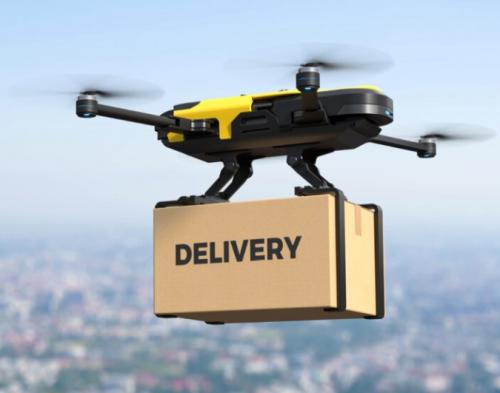The Delivery Drone Revolution: Taking Flight or a Grounded Dream?

Imagine a point in time where your online orders arrive at your doorstep not via a delivery truck, but a compact autonomous drone gently dropping off your package from the sky. A futuristic concept that was once resigned to sci-fi imaginings is now edging closer to reality, thanks to rapid advancements in drone delivery technology.
Importance of exploring its potential and challenges
As e-commerce continues booming and customer expectations intensify for lightning-fast shipping, major corporations have been racing to explore using unmanned aerial vehicles as a game-changing logistics solution. But is the world truly ready for armies of drones buzzing through our airspace? Let's take a balanced look at the opportunities and obstacles of this potentially revolutionary technology.
Benefits of Drone Delivery
A. Faster delivery times
One of the most obvious advantages drone delivery could provide is an unparalleled increase in speed and efficiency for last-mile shipments. With their ability to travel as the crow flies while circumventing road headaches like traffic jams and construction detours, drones could feasibly zip packages from warehouses to customers' doorsteps in a matter of minutes rather than hours or days.
B. Reduced traffic congestion
This enhanced speed isn't just a consumer convenience - it offers tremendous community benefits too. As online shopping surges to unprecedented levels, our roadways and city streets become even more clogged with fleets of delivery vans and trucks. A shift to aerial drone-based shipments could Help alleviate these traffic snarls.
C. Access to remote areas
From tall apartment buildings in crowded urban corridors to rural communities in difficult terrain, traditional truck-based logistics often struggle with that critical last-mile problem. But lightweight, nimble drones could deftly reach these underserved areas, ensuring everyone can receive prompt deliveries regardless of location.
Technological Advancements Needed
A. Battery life improvements
As enticing as drone delivery sounds in theory, the current technical limitations of uncrewed aviation pose a major hurdle. Put simply, today's commercial drones struggle with battery capacities powerful enough for robust, long-distance delivery routes while hauling any significant payload. Major leaps in lithium battery tech are required.
B. Safety regulations
If drone traffic does take to the skies en masse, ensuring public safety from these unmanned aerial vehicles is paramount. Clear enforceable regulations will need meticulous development - everything from software redundancies to prevent rogue drone behavior to secure air corridors segregated from traditional aircraft.
C. Air traffic management solutions
Integrating fleets of drones seamlessly into already-congested airspace demands sophisticated air traffic management capabilities and infrastructure we simply don't possess yet. Drone "highways" with clearly delineated routes and sensors to track vehicles will be critical. As will developing robust communication networks between drones and human operators.
Public Perception and Concerns
A. Privacy issues
Even if the technological challenges can be surmounted, developers of drone delivery face an equally tough personal battle in overcoming public apprehension about ubiquitous unmanned drones. Privacy advocates already sound alarms about the potential for mass overhead surveillance and violations of personal privacy.
B. Noise pollution concerns
Beyond feeling like Big Brother is literally watching from above, many locals shudder at the prospect of countless drones creating excessive noise pollution with their buzzing propellers in previously-tranquil neighborhoods. Mitigating sound disruptions is key for maintaining community support.
C. Addressing public apprehensions
Clearly transparent education campaigns are needed to reassure a wary public about safeguards against drones being weaponized or employed nefariously. Regulatory bodies must foster rigorous accountability for operators to cultivate trust. Giving communities a voice in how this technology develops locally could also ease concerns.
Companies Testing Drone Delivery
While debates swirl over drone delivery's viability, major companies aren't just idly pondering what-if scenarios. Industry giants like Amazon, Alphabet, UPS and FedEx have all allocated huge investments into ambitious drone programs. Amazon's Prime Air initiative alone has already logged thousands of flights.
Current progress and challenges faced
That said, these real-world tests have also laid bare the obstacles still to be cleared. Amazon's U.K. trials have already experienced drone crashes and navigation mishaps. And many pilots report aggressive territorial defense from unhappy nesting birds! Regulatory clearances for broader operations have also proved challenging.
Future Outlook
Despite the hurdles, many analysts foresee drone delivery overcoming its growing pains to become a mainstream reality over the next decade or so, maturing alongside supporting technologies like self-driving vehicles. Within cities, silent electric drones could whisk items like piping hot meals or medicine. Rural areas may see parallel growth.
To clear the path, we're likely to see continued breakthroughs in battery tech and ultra-precise GPS tracking to boost drone range, load capacities, and accuracy. Airspace integration systems will digitize our skies into a complex neural network capable of choreographing thousands of drones seamlessly. But maintaining rock-solid cybersecurity will also be paramount to prevent malicious drone hacking.
Conclusion
From faster deliveries and reduced road congestion to accessing hard-to-reach areas, drone delivery offers tantalizing potential to transform how goods are transported. But this burgeoning technology is still hamstrung by major obstacles in battery limitations, air traffic control integration, safety regulations, and public perception battles.
Companies like Amazon are making strides through ambitious real-world trials, and continued innovation in supporting technologies hints at an increasingly viable path forward. But whether drone delivery maintains society's excitement or flames out as an ungrounded pipe dream depends on the industry's ability to collaboratively solve the remaining technological and social challenges. The future remains intriguingly airborne.
Franklyn Ezeocha at Nairatop.com.ng says Hi!

Comments